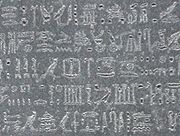
Brazier (hieroglyph)
Encyclopedia
The Ancient Egypt
ian Brazier hieroglyph is Gardiner
sign listed no. Q7 for the cooking brazier. It is shown from the Old Kingdom
in the style of a vertical burning flame upon four feet, but the hieroglyph has the flame hiding the fourth foot. Another Gardiner unlisted form has the four feet, with no flame, and in a plan view.

In the 196 BC
Rosetta Stone
, the Brazier hieroglyph is used two times, Rosetta lines R3, and R11; both are listings of sacrifices and offerings, as part of the nineteen reasons for rewarding pharaoh Ptolemy V, and thus creating the Rosetta Stone; (ten deeds are stated then to honor Ptolemy V, including creating, and erecting the Decree of Memphis (Ptolemy V) on the stela).
Both uses are the hieroglyph composition block
s for uah 'kh, for "burnt offerings".
Line R3 states: ".. He brought providing in them for their temples at
the festival
great, burnt offerings, [animals for] slaughter-(=sacrifices), drink offerings-(=libations), and things every usually made..."
Line R11 states: "Shall be offered a burnt offering...", ("emtutu uah a(kh)").
Ancient Egypt
Ancient Egypt was an ancient civilization of Northeastern Africa, concentrated along the lower reaches of the Nile River in what is now the modern country of Egypt. Egyptian civilization coalesced around 3150 BC with the political unification of Upper and Lower Egypt under the first pharaoh...
ian Brazier hieroglyph is Gardiner
Gardiner's Sign List
Gardiner's Sign List is a list of common Egyptian hieroglyphs compiled by Sir Alan Gardiner. It is considered a standard reference in the study of Ancient Egyptian hieroglyphs....
sign listed no. Q7 for the cooking brazier. It is shown from the Old Kingdom
Old Kingdom
Old Kingdom is the name given to the period in the 3rd millennium BC when Egypt attained its first continuous peak of civilization in complexity and achievement – the first of three so-called "Kingdom" periods, which mark the high points of civilization in the lower Nile Valley .The term itself was...
in the style of a vertical burning flame upon four feet, but the hieroglyph has the flame hiding the fourth foot. Another Gardiner unlisted form has the four feet, with no flame, and in a plan view.
Rosetta Stone usage

In the 196 BC
196 BC
Year 196 BC was a year of the pre-Julian Roman calendar. At the time it was known as the Year of the Consulship of Purpureo and Marcellus...
Rosetta Stone
Rosetta Stone
The Rosetta Stone is an ancient Egyptian granodiorite stele inscribed with a decree issued at Memphis in 196 BC on behalf of King Ptolemy V. The decree appears in three scripts: the upper text is Ancient Egyptian hieroglyphs, the middle portion Demotic script, and the lowest Ancient Greek...
, the Brazier hieroglyph is used two times, Rosetta lines R3, and R11; both are listings of sacrifices and offerings, as part of the nineteen reasons for rewarding pharaoh Ptolemy V, and thus creating the Rosetta Stone; (ten deeds are stated then to honor Ptolemy V, including creating, and erecting the Decree of Memphis (Ptolemy V) on the stela).
Both uses are the hieroglyph composition block
Quadrat (hieroglyph block)
A quadrat block is a virtual rectangle or square in Egyptian hieroglyphic text.The glyphs can be variable in number within the virtual block, though they are often proportioned according to variable standardized rules of scribal methods.The definition for the block in Illustrated Hieroglyphics...
s for uah 'kh, for "burnt offerings".
Line R3 states: ".. He brought providing in them for their temples at
Plinth (hieroglyph)
The Ancient Egyptian Plinth- hieroglyph is Gardiner sign listed no. Aa15 for the shape of a plinth, side view.-Plinth use as mortuary: "Justified":...
the festival
Jubilee Pavilion (hieroglyph)
The Jubilee Festival for the Pharaoh, the Heb Sed is represented in hieroglyphs by a Jubilee Pavilion Hieroglyph. It is Gardiner Sign Listed as no. O23. However it often appears with other pavilion, or festival hieroglyphs: the Hall, no. O22, O22 and an alabaster Basin, no. W3...
great, burnt offerings, [animals for] slaughter-(=sacrifices), drink offerings-(=libations), and things every usually made..."
Line R11 states: "Shall be offered a burnt offering...", ("emtutu uah a(kh)").
See also
- Gardiner's Sign List#P. Domestic and Funerary Furniture
- BrazierBrazierA brazier is a container for fire, generally taking the form of an upright standing or hanging metal bowl or box. Used for holding burning coal as well as fires, a brazier allows for a source of light, heat, or cooking...
- Lake of FireLake of FireA lake of fire appears, in both ancient Egyptian and Christian religion, as a place of after-death punishment of the wicked. The phrase is used in four verses of the Book of Revelation. The image was also used by the Early Christian Hippolytus of Rome in about the year 200 and has continued to be...

